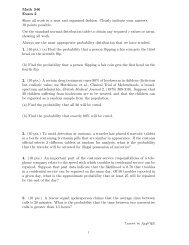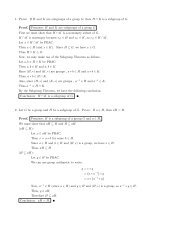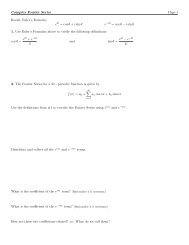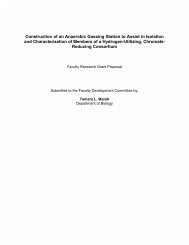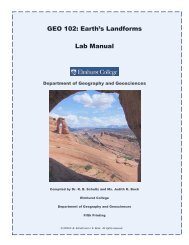Free Executive Summary - Elmhurst College
Free Executive Summary - Elmhurst College
Free Executive Summary - Elmhurst College
You also want an ePaper? Increase the reach of your titles
YUMPU automatically turns print PDFs into web optimized ePapers that Google loves.
Learning to Think Spatially: GIS as a Support System in the K-12 Curriculum<br />
http://www.nap.edu/catalog/11019.html<br />
SPATIAL THINKING IN EVERYDAY LIFE, AT WORK, AND IN SCIENCE 59<br />
3.5.4 The Next Steps: The Spatial Structure of the Solar System<br />
From this work on the shape and size of Earth, the next 2,000 years were marked by a struggle<br />
to come to grips with the spatial structure of the solar system. The search was an interesting one<br />
from the perspective of spatial thinking. Frequently, this search for an understanding of the structure<br />
of the solar system is described as a process of replacing the geocentric view of the universe<br />
with a heliocentric view. In a more fundamental spatial view, the search illustrates the power and<br />
implications of selecting an appropriate frame of reference.<br />
From the time that individuals began to make systematic observations of the objects in the sky,<br />
and until the time of Copernicus, the crucial task of astronomers was predicting the position of the<br />
moving celestial bodies as a function of time. These predictions were essential for their primary<br />
functions of time keeping, eclipse prediction, and generating horoscopes. The Ptolemaic universe,<br />
the dominant geocentric cosmology for many centuries, is a spatialization of a method used to<br />
predict the position of various celestial objects, such as the Moon and the planets that appeared to<br />
move against the backdrop of the fixed stars. In general, the “fixed stars” tended to retain their<br />
positions with respect to one another on an imaginary “celestial sphere,” which appeared to turn<br />
slowly around Earth, making one circuit every 24 hours. In contrast, the planets (then taken to be<br />
the Sun, Moon, Mercury, Venus, Mars, Jupiter, and Saturn) appeared to move irregularly with<br />
respect to the stars. The Sun and Moon always moved in one direction with respect to the stars,<br />
while the other planets moved at different speeds and sometimes even moved backwards (retrograde<br />
motion). Furthermore, the planets Mercury and Venus were never seen far from the Sun.<br />
These features were well known even to the earliest observers, and any explanation of the structure<br />
of the solar system had to explain these motions.<br />
The Ptolemaic system, set forth by Claudius Ptolemy in the Almagest around AD 150, was a<br />
refinement of earlier ideas. The major feature of the Ptolemaic system was the use of epicycles<br />
(Figure 3.3), or circles on circles, as a mathematical device to predict where a planet would be at<br />
any given time. The appropriate choice of epicycles could explain why Mercury and Venus were<br />
never seen too far from the Sun and could even explain the retrograde motion of the planets. The<br />
result was a remarkably good description of the relative motion of the objects in the solar system<br />
from the frame of reference of Earth.<br />
The major feature of the Ptolemaic view was the use of epicycles (Figure 3.4) to explain the<br />
retrograde motion of the outer planets (Figure 3.5). In essence, however, the result is simply a<br />
description of the relative motion of the objects in the solar system from the frame of reference of<br />
Earth.<br />
The Copernican cosmology can be viewed as a simple transformation of the motion of the<br />
same objects to the frame of reference of a fixed Sun. To the extent that the models of these<br />
respective universes are calibrated by observations, they have the same predictive power for a<br />
terrestrial observer interested in prediction. However, several steps, theology aside, led to the<br />
acceptance of the Copernican model. First, its elegant spatial simplicity was appealing. Next, the<br />
laws of planetary motion, derived from the model by Kepler, gave it some deeper appeal. Kepler’s<br />
laws were significant spatial generalizations about the relationships between the planets and the<br />
Sun. He not only inferred the elliptical nature of the orbits of the planets, but also provided a<br />
generalization that explained the orbits of all objects in terms of the period of rotation around the<br />
Sun and their distance from the Sun. By adopting elliptical orbits in a heliocentric system, Kepler<br />
was the first to be able to explain the retrograde orbit of the outer planets in modern terms (Figure<br />
3.5). Finally, through the application of the theory of gravitation, Newton gave the Copernican<br />
system grounding in first principles, assigning primacy to the mass of the Sun as a referent for the<br />
entire solar system.<br />
Copyright © National Academy of Sciences. All rights reserved.



